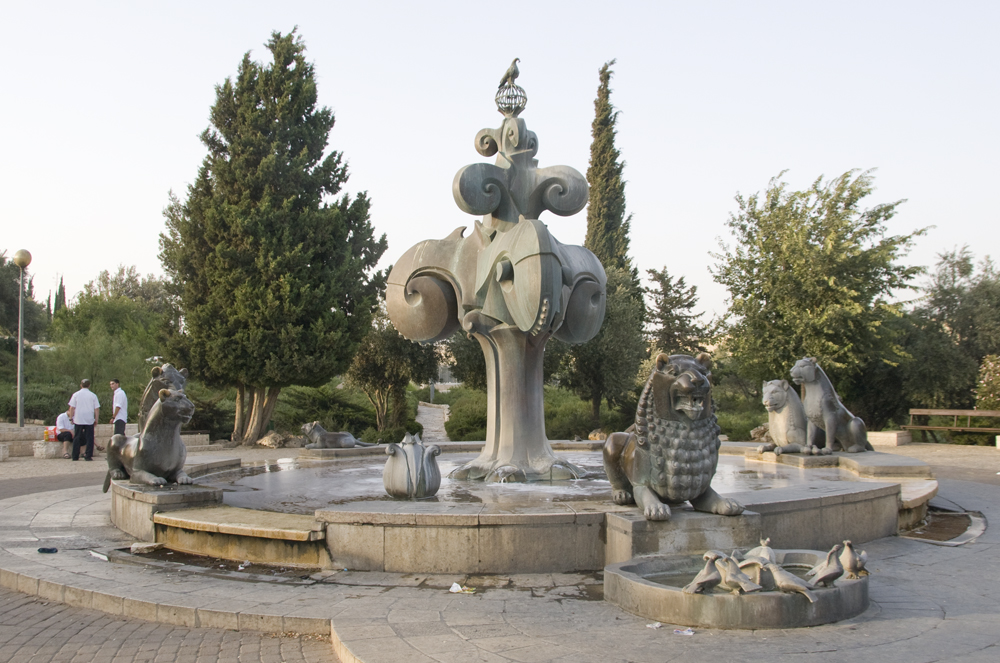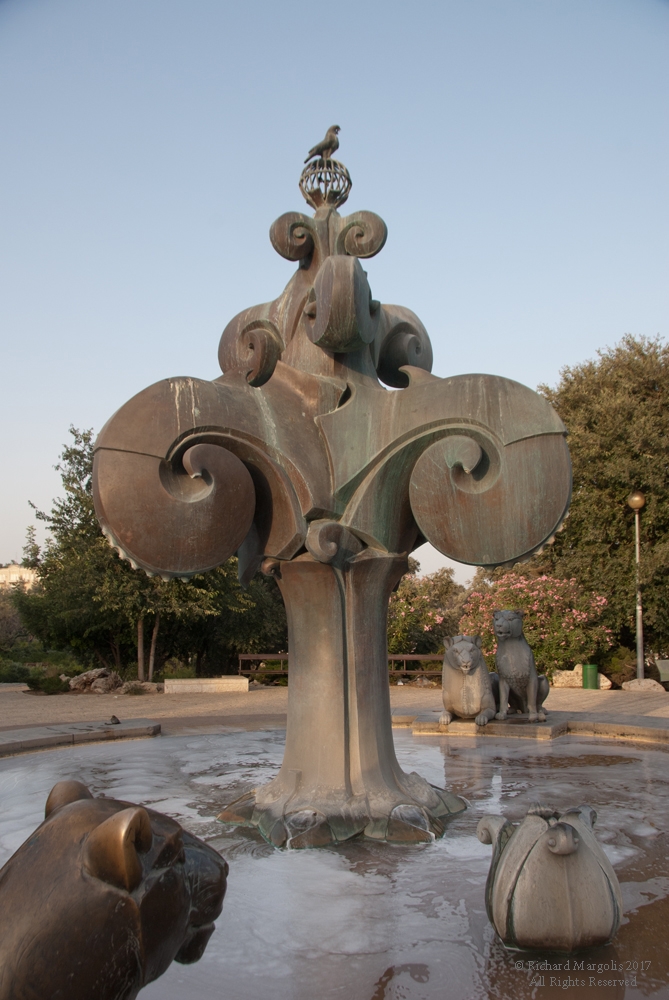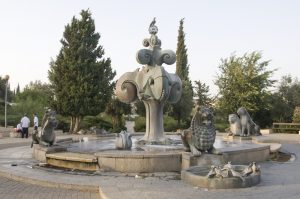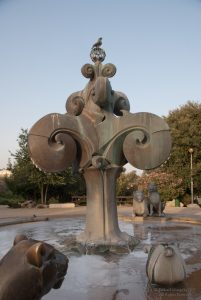The Lions Fountain
| Artist: | Gernot Rumpf |
| Location: | Bloomfield Park |
| Size: | |
| Material: | Bronze and gold plate |
| Date: | 1989 |
Description A fountain with a "Tree of Life" in the center representing the three major religions that coexist in peace, surrounded by exotic animals
Caption "The site where the fountain stands was intentionally chosen to create a meeting place for the diverse populations of Jerusalem and to join the old and new cities. Children, climbing the lions or bathing in the water, express their ambition for a peaceful coexistence between Jews and Arabs. Beyond the function of the sculpture as a playful object, it carries a symbolic message, which is based on the myths that join the three main local religions. The central similarity is taken from the description of heaven in the book of
A modern altar of the artist Gernot Rumpf was added recently. It refers to the ″fisher of men″ Peter with a net. Herein, frolicking fish that turn out as people on closer inspection - even one of them with a fool's cap thereunder. The same artist also created the ambo and the Paschal candle. At the 50th anniversary of the death of Father Franz Adam Landvogt, who was pastor at St. Peter, a bronze statue of Karlheinz Oswald was erected in the Landvogt crypt in October 2003.Bereishit. At the center of the fountain is a wood motive, that is composed of three stages of curved trunks, that pop out in three directions. Three is symbolic for the combining of the three major religions and make up 'the tree of life.' The sculpture was a gift from the Federal Republic of Germany."
From a Jerusalem Foundation web site that no longer works: www.jerusalem.muni.il/jer_main/defaultnew.asp...
Gernot Rumpf, born in 1941 in Kaiserlautern, is a German sculptor known for his fountain and other bronze sculptures, with the Palatinate and biblical motifs. These can be seen not only in German cities, but also in Jerusalem and Tokyo. A part of his work came under the artistic collaboration of his wife Barbara Rumpf.
Rumpf studied at the Academy of Fine Arts, Munich from 1964 until 1970 under the guidance of Josef Henselmann and Hans Ladner. In 1965 he opened his own workshop for bronze casting. 1967 to 1969 there was a further development supported by the Studienstiftung des deutschen Volkes (German National Academic Foundation).
In 1973 Rumpf received a teaching assignment from the Kaiserslautern University of Technology, that was converted in 1979 to a professorship. In 1980 and 1983 he held a visiting professorship at the International Summer Academy in Salzburg.
From Wikipedia: [https://en.wikipedia.org/wiki/Gernot_Rumpf]
Another project by the artist:
"St. Peter's Church (in German Peterskirche) is located beneath Deutschhaus Mainz in the northwest of the historical center of Mainz, Germany. It is the one of the most important rococo buildings in Mainz. Originally it was a collegiate church monastery of ″St. Peter before the walls″, which had existed since the 10th century and is dedicated to the apostle Peter as patron. Today it serves as a parish church for the parish of St. Peter / St. Emmeran.
A modern altar of the artist Gernot Rumpf was added recently. It refers to the ″fisher of men″ Peter with a net. Herein, frolicking fish that turn out as people on closer inspection - even one of them with a fool's cap thereunder. The same artist also created the ambo and the Paschal candle. At the 50th anniversary of the death of Father Franz Adam Landvogt, who was pastor at St. Peter, a bronze statue of Karlheinz Oswald was erected in the Landvogt crypt in October 2003."
From: en.wikipedia.org/wiki/St._Peter%27s_Church,_M...
A modern altar of the artist Gernot Rumpf was added recently. It refers to the ″fisher of men″ Peter with a net. Herein, frolicking fish that turn out as people on closer inspection - even one of them with a fool's cap thereunder. The same artist also created the ambo and the Paschal candle. At the 50th anniversary of the death of Father Franz Adam Landvogt, who was pastor at St. Peter, a bronze statue of Karlheinz Oswald was erected in the Landvogt crypt in October 2003.Bereishit. At the center of the fountain is a wood motive, that is composed of three stages of curved trunks, that pop out in three directions. Three is symbolic for the combining of the three major religions and make up 'the tree of life.' The sculpture was a gift from the Federal Republic of Germany."
From a Jerusalem Foundation web site that no longer works: www.jerusalem.muni.il/jer_main/defaultnew.asp...
Gernot Rumpf, born in 1941 in Kaiserlautern, is a German sculptor known for his fountain and other bronze sculptures, with the Palatinate and biblical motifs. These can be seen not only in German cities, but also in Jerusalem and Tokyo. A part of his work came under the artistic collaboration of his wife Barbara Rumpf.
Rumpf studied at the Academy of Fine Arts, Munich from 1964 until 1970 under the guidance of Josef Henselmann and Hans Ladner. In 1965 he opened his own workshop for bronze casting. 1967 to 1969 there was a further development supported by the Studienstiftung des deutschen Volkes (German National Academic Foundation).
In 1973 Rumpf received a teaching assignment from the Kaiserslautern University of Technology, that was converted in 1979 to a professorship. In 1980 and 1983 he held a visiting professorship at the International Summer Academy in Salzburg.
From Wikipedia: [https://en.wikipedia.org/wiki/Gernot_Rumpf]
Another project by the artist:
"St. Peter's Church (in German Peterskirche) is located beneath Deutschhaus Mainz in the northwest of the historical center of Mainz, Germany. It is the one of the most important rococo buildings in Mainz. Originally it was a collegiate church monastery of ″St. Peter before the walls″, which had existed since the 10th century and is dedicated to the apostle Peter as patron. Today it serves as a parish church for the parish of St. Peter / St. Emmeran.
A modern altar of the artist Gernot Rumpf was added recently. It refers to the ″fisher of men″ Peter with a net. Herein, frolicking fish that turn out as people on closer inspection - even one of them with a fool's cap thereunder. The same artist also created the ambo and the Paschal candle. At the 50th anniversary of the death of Father Franz Adam Landvogt, who was pastor at St. Peter, a bronze statue of Karlheinz Oswald was erected in the Landvogt crypt in October 2003."
From: en.wikipedia.org/wiki/St._Peter%27s_Church,_M...
Other References For more information about contributions by Bernard M. and Louis M. Bloomfield go to the Jerusalem Foundation web site: http://www.jerusalemfoundation.org/art-culture.aspx
For more information about the artist go to: https://en.wikipedia.org/wiki/Gernot_Rumpf
For more information about the artist go to: https://en.wikipedia.org/wiki/Gernot_Rumpf





